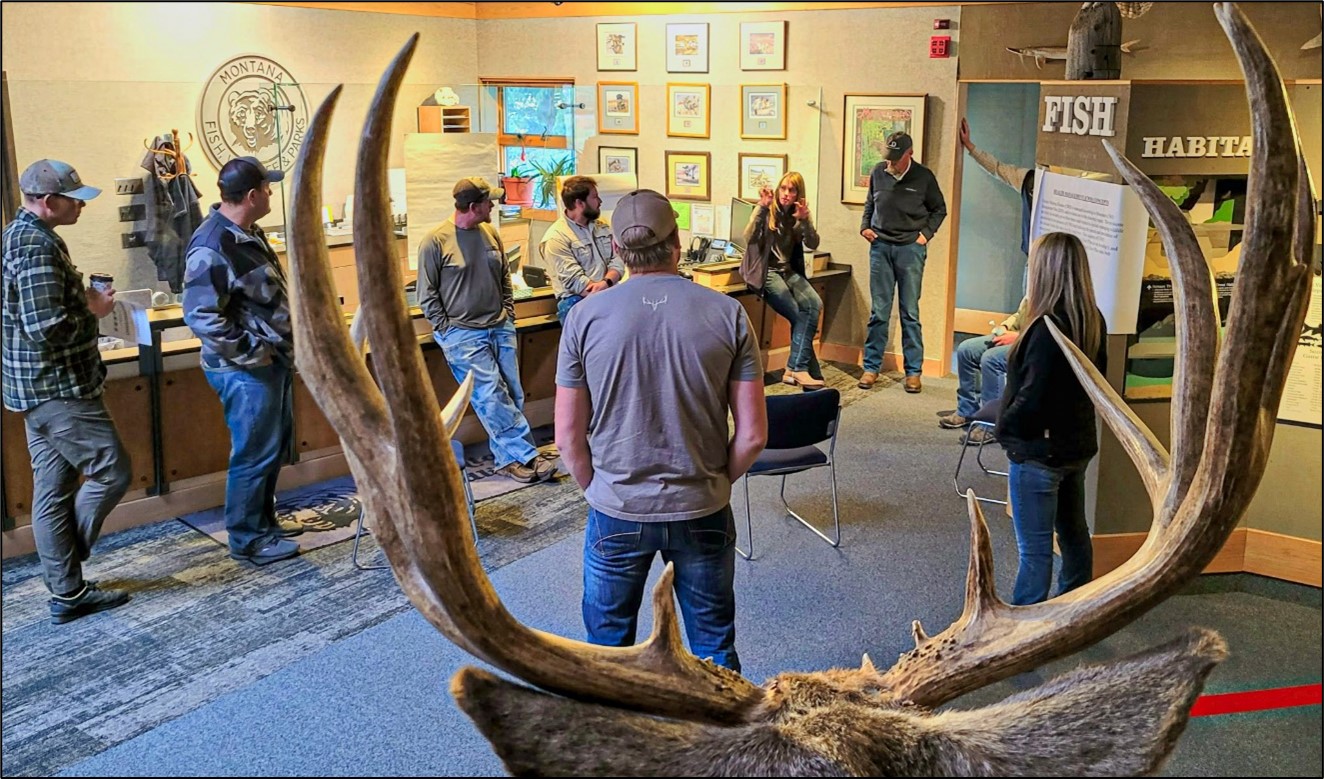HELENA — Montana hunters delivered a clear message to Fish, Wildlife & Parks during statewide workshops on a new Mule Deer Management Plan: prioritize resident hunting opportunities over nonresident access as the agency addresses declining populations.
Nearly 150 hunters attended workshops across the state’s seven regional headquarters, with participants from western prairies to mountain valleys consistently calling for reduced nonresident licenses and better protection of resident hunting opportunities.
Beyond the resident-first theme, hunters across regions also pushed for mandatory harvest reporting, stronger predator management and habitat improvements through timber treatments and prescribed fire. The cross-regional consensus on these issues signals broad agreement among Montana hunters on key management strategies, despite varying local priorities.
“In parts of the state, especially eastern Montana, there’s a lot of concern over mule deer,” said FWP Director Christy Clark. “We recognize our great state’s wildlife are the public’s resources, and we need to manage them for present and future generations.”
Interactive Format Drives Discussion
The workshops featured small-group rotations through interactive discussions on three key management areas: harvest, habitat and herd health. Participants then identified what they felt were the most important objectives from each session.
“It’s important for people to know they are being heard when they voice their frustrations with the mule deer populations and how we’ve seen significant decline,” said Quentin Kujala, FWP chief of conservation policy. “People were very willing to participate in these interactive meetings and provide invaluable feedback for us to implement in our new plan.”
FWP plans to use the workshop objectives as guidelines for drafting the management plan, with additional public input opportunities scheduled before completion.
Regional Perspectives Emerge
The workshops revealed distinct regional priorities and concerns across Montana’s diverse hunting landscapes.
Western Montana Focus
In western Montana, discussions centered on license allocation and habitat management. Hunters expressed interest in examining the pros and cons of general license opportunities versus limited permits.
“Effective wildlife management requires input from the public, and the attendees at the meeting provided valuable insight into their perspective on what it takes to manage for an increasing mule deer population in northwest Montana, something everyone agreed they would like to see,” said Neil Anderson, FWP Region 1 wildlife manager.
Key western Montana priorities included:
- Mandatory harvest reporting
- Reducing nonresident opportunities before cutting resident hunting
- Finding alternatives to managing for low buck-to-doe ratios
- Improving habitat through timber treatments and prescribed fire
- Expanding migration and mortality research to neighboring states
- Using hunters and trappers to reduce predator populations
Central Montana Concerns
Central Montana hunters focused heavily on hunting season structures and chronic wasting disease management.
“The thoughtful dialogue and honest feedback we received will be invaluable as we shape a new plan that reflects the values and priorities of Montanans,” said Warren Hansen, Region 3 wildlife manager.
At the Billings workshop, attendees stressed the need for stricter permit requirements and limitations on hunting during the rut.
“Many attendees made suggestions, such as stricter permit requirements and limiting hunting during the rut, to reduce their opportunities today to ensure the longevity of this iconic Montana species into the future,” said Matt Ladd, Region 5 wildlife manager.
Central Montana participants also voiced ongoing concerns over CWD impacts and emphasized the need for increased disease outreach and education.
Eastern Montana Priorities
Eastern Montana workshops drew significant attendance, reflecting the passion for mule deer hunting on the prairie landscape that attracts both local and nonresident hunters.
Harvest management dominated discussions, with participants focusing on reducing hunter crowding and improving opportunities for Montana residents.
“Our harvest management station definitely had the most interest in the room,” said Scott Thompson, FWP Region 6 wildlife manager. “The main takeaways were reducing hunter crowding and providing better opportunity for Montana residents.”
The Miles City workshop highlighted conflicting viewpoints within the hunting community regarding older-class bucks and CWD management.
“Most people want to see older class bucks, but if they are more likely to have CWD and the plan is to get rid of them, we may need to increase the public’s understanding of this concept,” said landowner/outfitter Todd Steadman.
Eastern Montana priorities included:
- Increasing mule deer populations by reducing doe harvest on all land ownerships
- Better protection and management of winter range areas
- Mandatory reporting with physical inspections of harvested bucks
- Reducing nonresident license numbers within hunting districts
- Shortening the general season
Plan Timeline and Scope
The new Mule Deer Management Plan is slated for completion by the end of 2026. According to FWP, the plan will reflect public concerns voiced over recent years while incorporating the latest science and research on mule deer populations and management.
The comprehensive plan will provide guidance for FWP’s mule deer management and include strategies addressing hunting harvest, habitat conservation and herd health management.
“Discussion on harvest management focused primarily on the increase in nonresident hunters, as well as what steps could be taken to increase mule deer populations when they are low,” said Scott Dorak, FWP Region 7 wildlife manager. “The public wants to see us increase populations by reducing antlerless harvest on all land ownerships, which is part of our strategy.”
